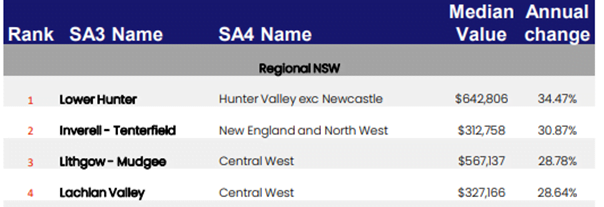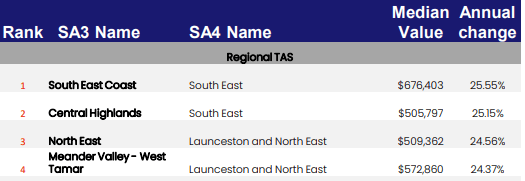
Listen and subscribe
Apple  Android
Android 
In this week’s episode, Dave, Cate and Pete take you through:
How have capital cities performed vs rest of state regions pre and post – covid
- Sydney/NSW – Sydney and regional NSW increased at exactly the same amount pre-COVID-19 – 98% increase in property prices.
- Sydney/NSW – Regional NSW performed far better than Sydney if you include the two COVID-19 years – 224% (regional NSW) vs 159% (Sydney)
- Melbourne/Victoria – Melbourne was the better performer pre COVID-19 – 147% vs 122%.
- Melbourne/Victoria – Regional Victoria zoomed ahead of Melbourne during COVID-19 – 264% (regional Victoria) vs 215% (Melbourne)
- Brisbane/QLD – Regional QLD was the better performer pre COVID-19 – 118% vs 101%.
- Brisbane/QLD – Brisbane is the better performer when you include COVID-19 – 193% vs 169%
- Adelaide/SA – Adelaide was the better performer during both periods – 101% (pre COVID-19) and 177% (including COVID-19)
- Perth/WA – Regional WA was the better performer during both periods – 111% (pre COVID-19) and 166% (including COVID-19)
- Hobart/TAS – Hobart was the better performer during both periods.
- Hobart/TAS – Hobart was the best performing location in the nation – 220% (pre-COVID-19) and 356% (including COVID-19)
- Darwin/NT – Darwin was the better performer during both periods – 120% (pre-COVID-19) and 180% (including COVID-19)
- Canberra – Canberra house prices increased 100% pre-COVID-19
- Canberra – Canberra house prices increased 196% including COVID-19
PRE-COVID-19: 2003 to March 2020
- Hobart – 220%
- Tas regional – 168%
- Melbourne – 147%
- Vic regional – 122%
- Darwin – 120%
- QLD regional – 118%
- NT regional – 115%
- WA regional – 111%
- Perth – 102%
- Adelaide – 101%
- Brisbane – 101%
- Canberra – 100%
- Sydney – 98%
- NSW regional – 98%
- SA regional – 93%
INCLUDING COVID-19: 2003 to March 2022
- Hobart – 356%
- TAS regional – 316%
- Vic regional – 264%
- NSW regional – 224%
- Melbourne – 215%
- Canberra – 196%
- Brisbane – 193%
- Darwin – 180%
- Adelaide – 177%
- QLD regional – 169%
- WA regional – 166%
- Sydney – 159%
- SA regional – 141%
- NT regional – 136%
- Perth – 133%
Statistical Area Level 3 (SA3) – what is it?
- Statistical Areas Level 3 (SA3) are geographical areas built from whole Statistical Areas Level 2 (SA2).
- They have been designed for the output of regional data, including 2016 Census data.
- SA3s create a standard framework for the analysis of ABS data at the regional level through clustering groups of SA2s that have similar regional characteristics.
- Whole SA3s aggregate to form Statistical Areas Level 4 (SA4).
- In the major cities, SA3s represent the area serviced by a major transport and commercial hub. They often closely align to large urban Local Government Areas (e.g. Gladstone, Geelong).
- In outer regional and remote areas, SA3s represent areas which are widely recognised as having a distinct identity and similar social and economic characteristics.
- There are 358 spatial SA3 regions covering the whole of Australia without gaps or overlaps.
Regional NSW – Highest performers

Drivers of regional growth – Lower Hunter
- Proximity to the major capital city – 50 mins to Newcastle, 1 hr 50 mins to Sydney
- Proximity to beach – 49 mins
- Ave climate – winter 18-20 degrees
- Population – est 94,734 (2020) / Newcastle 322,278 (2016) / Sydney 6.13M (2021)
- Median age – 8 (2020) / 38 years NSW (2016)
- Median income – $52,252 (2020)/ $51,389 NSW (2019)
- Older towns – 1830
- Quality of local nature –national parks, lakes, world heritage wilderness area. Vinyards one of Australia’s oldest grape-growing regions. Dining – artisan foods and farm-fresh produce, farmers markets. Day spas, golf courses, hunter valley zoo
- Towns in the region –
- Singleton
- Cessnock
- Branxton
- Industry – The Hunter is Australia’s largest regional economy, valued at over $40 billion. The region prospers economically and socially, supported by a highly professional and skilled workforce and strong research, health, tourism, manufacturing and defence sectors.
- Farming – Herbs, Apples, Turkeys, Sweet corn, Lettuce, Pears, Plantation fruits, Nurseries, outdoor Mushrooms, Almonds, Bananas, Tomatoes, Macadamias, Grapevines, Cut flowers, Pecans, Grapes for wine, Avocados, Cultivated Turf Raspberries, Strawberries, Mangoes
- The Port of Newcastle is the largest coal export port in the world, with its overall exports valued at almost $18.5 billion in 2016-17.
- Williamtown RAAF base sits at the heart of the region’s defence sector and is supported by a hub of important defence and aerospace companies. It is co-located with the Newcastle Airport, currently servicing 1.2 million passengers annually.
Regional VIC

Drivers of regional growth – Colac-Corangamite
- Proximity to the major capital city – 60 mins to Geelong, 1 hr 50 to Melbourne
- Proximity to beach – 48 mins to Lorne
- Ave climate – winter 4-13 degrees
- Population – est 37,498 (2020) / Geelong 253,269 (2016) / Melbourne 5.08M (2019)
- Median age – 46.2 (2020) / VIC 38 (2021)
- Median income – $43,674 (2019) / $51,027 (2019)
- Older towns – proclaimed a shire in 1864, by 1870’s almost 700 people lived there
- Towns in the region –
- Apollo bay
- Cobden
- Camperdown
- Terang
- Quality of local nature – rural town set amongst picturesque volcanic plains and 30+ lakes, surrounded by quaint townships and offering a smorgasbord of things to do and see, botanic gardens, rainforest and tree top walk, heritage buildings, bird sanctuary, museums, cycling track following Old Beechy Rail Trail, wining and dining
Regional QLD

Drivers of regional growth – Gold Coast Hinterland
- Proximity to the major capital city – 23 mins to Surfers paradise, 1 hr to Brisbane
- Proximity to beach – 23 mins to Surfers Paradise
- Ave climate – winter 9-21 degrees
- Population – est 20,350 (2020) / Surfers paradise 23,689 (2016) / Brisbane 2.28M (2016)
- Median age – 46.1 (2020) / QLD 38.5 (2021)
- Median income – $48,596 (2019) / $50,298 (2019)
- Older towns – 1865
- Quality of local nature – premier holiday destination/activities, theme parks, beaches, shopping, night life, vinyards, waterfalls, national parks, outdoor activities (high ropes/zipline)
Regional SA

Drivers of regional growth – Limestone Coast
- Proximity to the major capital city – 3 hrs 30 mins to Adelaide, 2 hr 20 mins to Horsham VIC
- Proximity to beach – on the beach
- Ave climate – winter 5-14 degrees
- Population – est 67,365 (2020) / Horsham 14,453 (2016) / Adelaide 1.3M (2016)
- Median age – 6 (2020) / 41 (2021)
- Median income – $45,601 (2019) / SA $49,888 (2019)
- Older towns – settled since 1840’s
- Towns in the region –
- Mount Gambier
- Penola
- Coonawarra
- Naracoorte
- Kingston
- Industry – It is built from traditional agriculture based activities, but has now expanded to include forestry, manufacturing, tourism, engineering, transport, retail, health, education and service industries.
- Quality of local nature – The Limestone Coast has jaw-dropping natural wonders, lush wine country, sprawling sandy-white beaches and unique experiences to spark your curiosity – lakes, sink holes, beach, caves, national parks, wine regions (Coonawarra). Mount Gambier – second largest town in South Australia
Regional TAS

Drivers of regional growth – South East Coast
- Proximity to the major capital city – 1 hr to Hobart
- Proximity to beach – on the beach
- Ave climate – winter 4-13 degrees
- Population – est 7,199 (2020) / Hobart 206,097 (2016)
- Median age – 56.6 (2020) / 42 (2021)
- Median income – $37,487 (2019) / TAS $47,352 (2019)
- Older towns – settled since 1831
- Towns in the region –
- Orford
- Triabunna
- Swansea
- Coles Bay
- Industry – Tasmania is truly the breadbasket of Australia – the carrots, broccoli, peas, beans, cauliflower, potatoes, barley, wheat, oats, apples, pears, apricots and cherries, Vinyards, meat and dairy
- Quality of local nature – vinyards, beach, national parks, Island national parks
Regional WA

Drivers of regional growth – Manjimup
- Proximity to the major capital city – 1 hr 30 mins to Bunbury, 3 hr 15 mins to Perth
- Proximity to beach – on the beach
- Ave climate – winter 7-15 degrees
- Population – est 23,253 (2020) / Bunbury 43,310 (2021) / Perth 1.98M (2016)
- Median age – 48.1 (2020) / 36 (2016)
- Median income – $39,670 (2019) / WA $54,220 (2019)
- Older towns – settled since 1856, took off in 1910 as a result of railway line that was built
- Towns in the region –
- Manjimup
- Pemberton
- Northcliffe
- Donnybrook
- Industry – agriculture, timber, tourism and public administration.
- Quality of local nature – Margaret River, State forests, lake, beach




